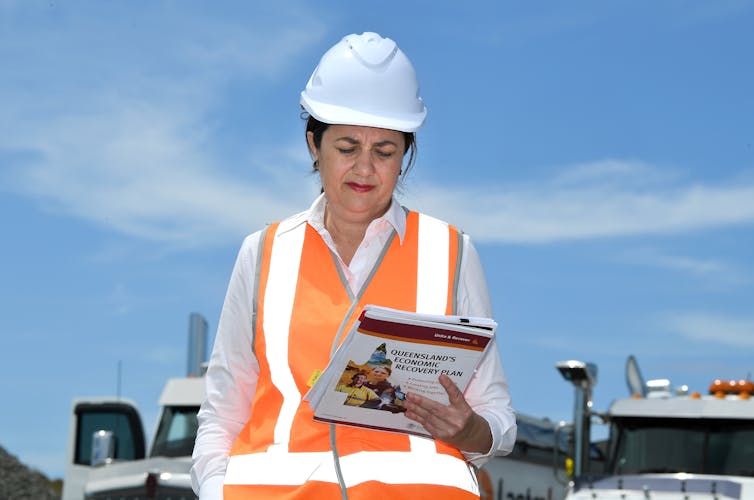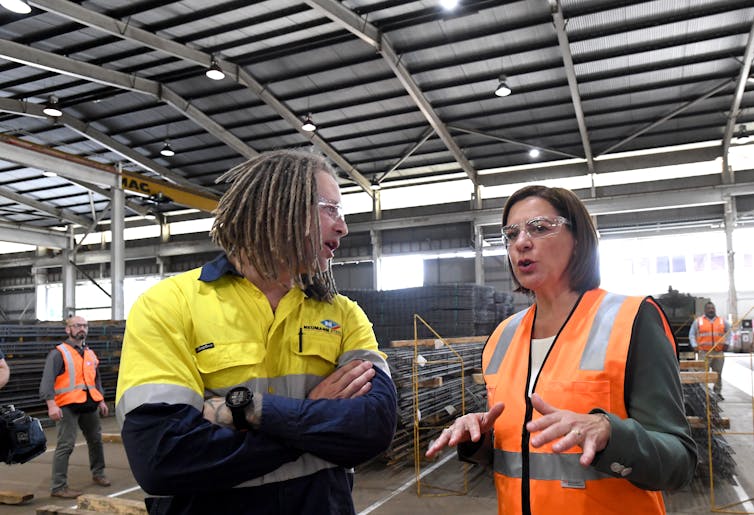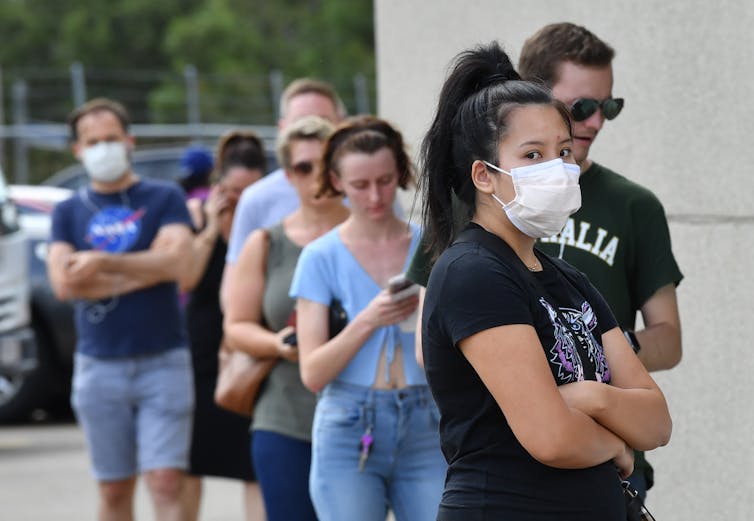Source: The Conversation (Au and NZ) – By Susan Harris Rimmer, Professor and Director of the Policy Innovation Hub, Griffith Business School, Griffith University
The Queensland election is a history-making poll. For the first time in a state or federal election, two women are going head-to-head.
Does this mean gender equality issues are finally writ large across an election campaign?
Sadly, neither Labor’s Annastacia Palaszczuk, nor the Liberal National Party’s Deb Frecklington appear to be interested in highlighting the needs and perspectives of women ahead of election day on October 31.
Women making political history in Queensland
Labor goes into this election with a remarkably strong — and rare — record of female ministers in recent years.
In 2009, Anna Bligh became the first woman in Australia to win an election as premier. Six years later, Palaszczuk was the first woman to lead an opposition into government.She also had the first female dominated-cabinet in Australian history – with eight out of the 14 ministers being women in 2015. After the most recent reshuffle this year, eight of Palaszczuk’s 18-member cabinet were women.
Read more: As the Queensland campaign passes the halfway mark, the election is still Labor’s to lose
For the Queensland LNP, Frecklington is making history as their first female leader. But she is one of just five women in the LNP’s 23-member shadow ministry.
Despite these achievements, the proportion of women running in the 2020 election isn’t substantially different to the past. Across all 597 candidates, only 219, or 37%, are women. This is up from 32% in the 2017 election.
So, overall, progress is is being made, but slowly.
Hard hats and hi-vis
And just because both leaders are women, this does not mean “women’s issues” or even a focus on female perspectives is featuring prominently in the campaign. On the contrary.

COVID-19 has hurt women’s work more than men’s, leading to a so-called “pink recession”. Women are more likely to be in part-time, casual or insecure work, and to work in industries most affected by lockdowns or economic downturn, such as retail and hospitality, tourism, human services, creative arts and universities.
Despite this, the leaders are making male-dominated industries the focus of their campaigns.
Both Palaszczuk and Frecklington have made frequent appearances in hi-vis vests and hard hats, talking up policies around infrastructure, roads and other developments to boost the state’s economy.

While hi-vis may be convenient shorthand for “jobs”, it’s lazy politics. And it doesn’t make sense in this particular election, given the extent to which women have been affected by COVID-19.
What gender issues are featuring in the campaign?
There are some exceptions to the hard hat focus, however, and these are notable ones – even if they are not generating significant attention on the campaign trail.
The ALP has pledged free sanitary pads and tampons for 120 schools “most in need”. This would make Queensland only the second state, after Victoria, to offer a program like this.
On Thursday, the LNP said it would spend A$70 million to improve before and after school care and a further A$10 million to subsidise childcare training courses.
Both major parties are also taking significant domestic violence policies to the polls.
Following the murder of Brisbane woman Hannah Clarke and her three children in February, the LNP announced a package including laws against coercive control and emergency accommodation grants.
Read more: Australia is not ready to criminalise coercive control — here’s why
Earlier this month, the Palaszczuk government also pledged to do more to tackle coercive control, including training programs for first responders and a community awareness campaign, although has stopped short of specifically promising new laws.
Abortion law concerns
In disturbing news for women’s advocates, Frecklington has also committed to a review of the state’s abortion laws in her first term of government, with a focus on the gestational limit for terminations.
The anti-abortion lobby are backing the LNP and Moggill LNP candidate Christian Rowan has reportedly given assurances to Christian groups about repealing hard-won abortion laws.
While it seems Frecklington is attempting to distance herself from the debate — saying it is not a “priority” — it is a worrying proposal for women specifically and the state more generally.
Are the leaders feminists?
Gender issues also got some attention in the second week of the campaign, after the leaders were questioned about their views on feminism. It wasn’t exactly a Helen Reddy “hear me roar” moment.
Asked whether she would describe herself as a feminist, Palaszczuk said, “if a feminist is about believing in equality, absolutely”.
Frecklington was even more noncommittal.
I identify as a female who wants to get Queensland working again.
Undermined from within
In Australian politics, we are used to women politicians being undermined by the media, opposition and even their own parties.
During this campaign, we have seen little media undermining on gender, perhaps because both leaders are women and their gender is not seen as a point of difference.
But we have seen further demonstration of female leaders being attacked from within.
In the early stages of the campaign, the ABC reported Frecklington had been referred to the Electoral Commission of Queensland by her own party over fundraising concerns. The LNP denies this, and Frecklington denies any wrongdoing.
The episode has not dominated the campaign since it was reported in mid-October. But it will only serve to make her leadership more precarious, should the LNP lose on October 31.
Not that it was particularly secure to begin with. This follows intense speculation about a leadership spill ahead of the election campaign.
So far, women appear to back the ALP
In the meantime, the major parties need women’s votes to win. The latest Roy Morgan Poll for Queensland shows the key to the ALP’s slim lead in week three of the campaign comes via its support from women.

Women favour the ALP 53.5% over LNP 46.5% on a two-party preferred basis, while men more narrowly favour the LNP 51.5% to 48.5% (overall, the ALP has its nose in front, 51% to 49%).
Women’s perspectives may not be dominating the campaign but they may be being crucial when it comes to the result.
Regardless of the election outcome, we can be sure that without either leader stepping up more strongly for women — and being supported by their parties to do so — this election will also be a historic lost opportunity.
– ref. Queensland is making election history with two women leaders, so why is the campaign focused on men? – https://theconversation.com/queensland-is-making-election-history-with-two-women-leaders-so-why-is-the-campaign-focused-on-men-148261







